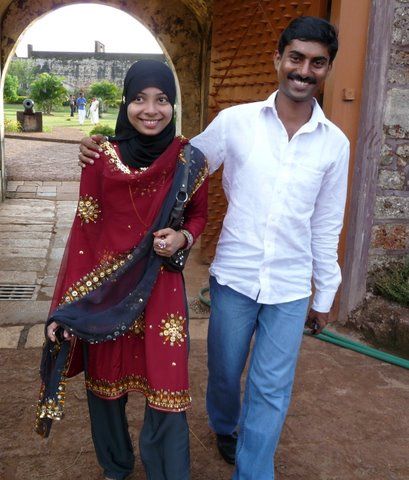Kozhikode (Calicut) November 21 – A specter is haunting India's state of Kerala, a supposedly new and secret Islamic weapon, "love jihad." Namely, the idea that young Muslim men court impressionable Hindu and Christian women to capture their souls as well as their bodies. In the Malabar region, where the majority of Kerala's most venerable Muslim community lives, it is whispered that as many as four thousand women have already succumbed. Can it be? Will seduction threaten the communal peace in this tolerant multicultural state?
By chance, we arrived in Kozikode on the day riot police dispersed hundreds of demonstrators belonging to Hindu Aika Vedi (HAV) as they marched within a hundred meters of an Islamic social center. It was actually a "conversion center," the protestors insisted as a large crowd led by the Sunni Students Federation (SKSSF) gathered to protect the threatened social center. City authorities invoked a law banning provocative assemblies, a riot was averted, and the crowd dispersed. A newspaper account was careful to state that during the agitation, Hindu leaders of HAV escorted a pregnant Muslim woman in a jeep to the local women's hospital.
It also happened that we were meeting two highly respected Muslim leaders: A Congress Party veteran, T. Sadarikkoya, who as a youngster took part in Gandhi's "Quit India" campaign in 1943; and Prof. M.N. Karassery of Calicut University, a leading authority on Kerala's Malayalam language and a widely read columnist.
Both agreed that yes, there were communal problems. Fundamentalists have been proselytizing, and its effects are evident in the prevalence of hijabs worn by a growing minority of Muslim women. But Malabar had its distinct civil culture. Whereas Muslims in India's Northern provinces arrived as conquerors, their brothers arrived in Malabar some 450 years ago as traders. With rare exceptions, they have lived in peace alongside Hindus and Christians. Another unifying factor, Professor Karassery, stressed is that while a common language, Urdu, unites northern Indian Muslims and Pakistanis, the Malabar Muslims share the same language, Malayalam, with Hindus and Christians. Thus during the bloody exchange of populations that occurred when India and Pakistan gained independence in 1947 there were no riots in Kerala, and few Muslims migrated northward.
Besides, Muslims account for a quarter of Malabar's inhabitants, a potent electoral bloc in a state where left- and center coalitions have for decades rotated in office, and where as many as 85 percent of eligible voters go to the polls. In Sadarikkoya's summary, "The Muslims hold the balance of power in Kerala's elections." Or as Karassery elaborated, "Our community is not under the shadow of attack, it has political power, it has access to the media. Both parties [Congress and the now-governing local Communist Party] are power-mongering. There is no real difference between the parties on communal issues."
So what of the "love jihad"? The professor was scornful: "No source has been given for those four-thousand conversions. It's a fabrication. Nor is there anything to the story [spread by Hindu fundamentalists] that the Christians are paying Hindus to convert. The real reason for such stories is that the appeal of fundamentalist parties is fading, and they need an issue to rouse their communities."
It appears that as of the moment, Kerala's civil center is holding.



